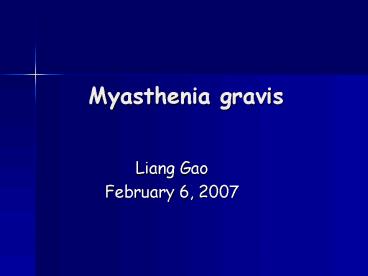Myasthenia gravis - PowerPoint PPT Presentation
1 / 14
Title:
Myasthenia gravis
Description:
Myasthenia gravis (MG) is a neuromuscular disease leading to fluctuating muscle ... What is Myasthenia gravis?-Cont. ... Myasthenia gravis: past, present, and future' ... – PowerPoint PPT presentation
Number of Views:3988
Avg rating:3.0/5.0
Title: Myasthenia gravis
1
Myasthenia gravis
- Liang Gao
- February 6, 2007
2
What is Myasthenia gravis?
- Myasthenia gravis (MG) is a neuromuscular disease
leading to fluctuating muscle weakness and
fatigability - 14 per 100,000 (in the U.S.), one of the lesser
known autoimmune disorders - Caused by the failure of neuromuscular
transmission - Symptoms characteristic muscle weakness that
worsens after use of affected muscles. 2/3 of
patients, the extrinsic ocular muscles (EOMs)
present the initial symptoms. The symptoms
usually progress to the other bulbar muscles and
limb muscles, resulting in generalized MG (gMG)
3
What is Myasthenia gravis?-Cont.
- Biding of autoantibodies to proteins involved in
signaling at the neuromuscular junction (NMJ) - AChR (Acetylcholine Receptor) Muscle-specific
tyrosine kinase (MuSK) involved in AChR
clustering - People treated with penicillamine can develop MG
symptoms--antibody titer is usually similar to
that of MG, but both the symptoms and the titer
disappear when drug administration is
discontinued.
4
- Each axon Branch contain acetylcholine (Ach)
loaded synaptic vesicles - Synaptic cleft contains acetylcholinesterase
(AChE) and other proteins and proteoglycans
involved in stabilizing the NMJ structure - Postsynaptic membrane has characteristic deep
folds the AChR is densely packed at the tops of
the folds
5
- Nerve action potential reaches the synaptic
button--voltage-gated Ca2 channels open - Ca2 influx -- synaptic vesicles with ACh release
- ACh binds to AChR--triggering the opening of its
Na channels and influx of Na - Endplate potential (EPP) activates voltage-gated
Na channels, leading to further influx of Na
and spreading of the action potential along the
muscle fiber - Anti-AChR Abs affect neuromuscular transmission
by at least 3 mechanisms
6
- Ab binding to the AChR activates the complement
cascade - Formation of membrane attack complex (MAC) and
localized destruction of the postsynaptic NMJ
membrane. - A simplified, altered morphology of the
postsynaptic membrane of the NMJ of MG patients,
which lacks the normal deep folds and has a
relatively flat surface
7
- Accelerated degradation of AChR molecules
crosslinked by Ab - Functional AChR block
8
Results
- A reduction in the number or activity of the AChR
molecules at the NMJ - Decreased EPP, which may still be adequate at
rest - After repetitive activity of ACh release, the EPP
may fall below the threshold needed to trigger
the action potential
9
Pathophysiology
- The antibodies are produced by plasmacells, that
have been derived from B cells - These plasmacells are activated by T-helper(CD4
T) cells, which in turn are activated by binding
to acetylcholine receptor antigenic peptide
sequences (epitopes) that rest within the
histocompatibility antigens of antigen precenting
cells - The thymus plays an important role in the
development of T-cells, which is why myasthenia
gravis is associated with thymoma - Slight genetic predisposition particular HLA
types seem to predispose for MG
10
Diagnosis
- Difficult for diagnosis, as the symptoms can be
subtle and hard to distinguish from both normal
variants and other neurological disorders and
always take years for the right diagnosis - Physical examinationMuscle fatigability
- Blood testsAb
- Repetitive nerve stimulation--repeatedly
stimulating a muscle with electrical impulses - Pathological findings--Immunofluoresence shows
IgG antibodies on the NMJ Muscle electron
microscopy shows receptor infolding and loss of
the tips of the folds
11
Treatment
- Direct improvement of the weakness
- Improved muscle function by cholinesterase
inhibitors--slow the natural enzyme
cholinesterase that degrades acetylcholine in the
motor end plate the neurotransmitter is
therefore around longer to stimulate its receptor
- Reduction of the autoimmune process
- Treated patients with a combination of
immunosuppressive drugs with a cholinesterase
inhibitor
12
Treatment-Cont.
- Serious Patents Plasmapheresis is used to remove
the putative antibody from the circulation
Intravenous immunoglobulins (IVIg) is used to
bind the circulating antibodiesshort time
benefits - Thymectomy (removal of the thymus gland) can
improve symptoms in more than half of
patientspositive effects be seen within weeks to
as much as 3-5 years after surgery
13
Reference
- Bianca M. Conti-Fine, Monica Milani, and Henry J.
Kaminski. Myasthenia gravis past, present, and
future. The Journal of Clinical Investigation,
Volume 116, Number 11, 2006 - Scherer K, Bedlack RS, Simel DL. "Does this
patient have myasthenia gravis?". JAMA 293
1906-14, 2005 - Bedlack RS, Sanders DB. "How to handle
myasthenic crisis. Essential steps in patient
care.". Postgrad Med 107 211-4, 220-2. 2000 - Myasthenia Gravis, Foundation of America, INC
- http//www.myasthenia.org/
- The Myasthenia Gravis Associatoin
- http//www.mgauk.org/
14
Questions?

